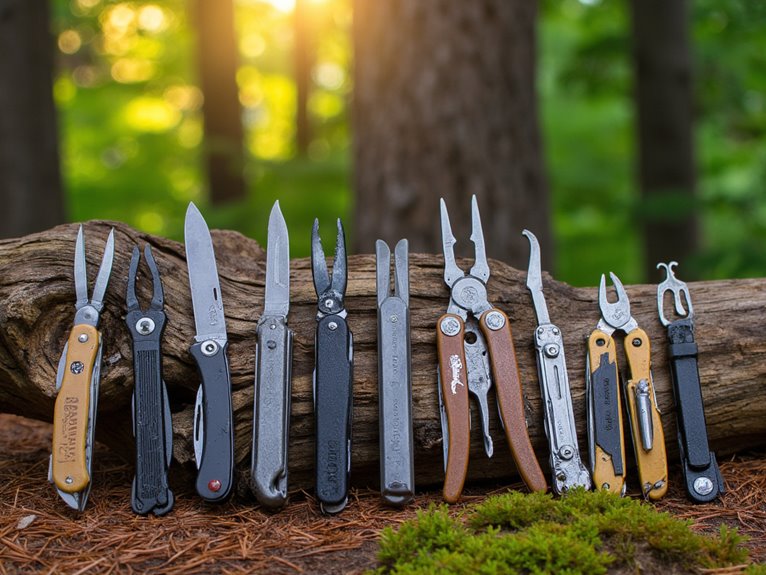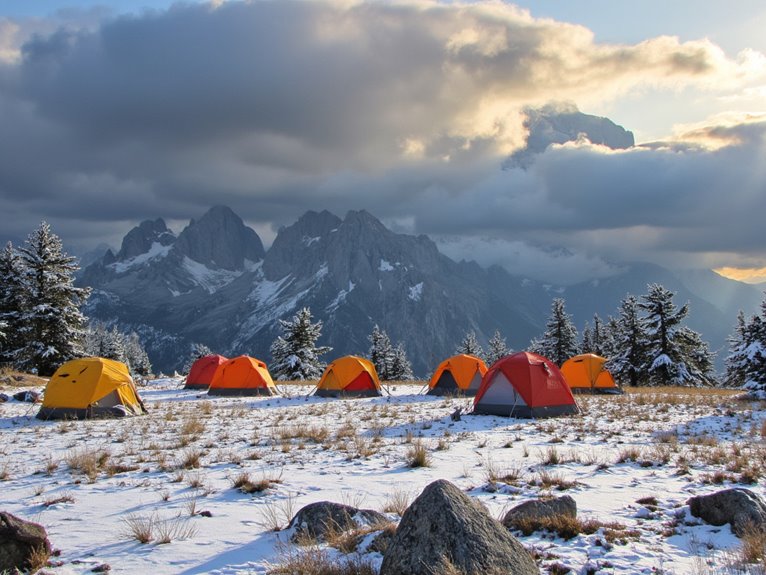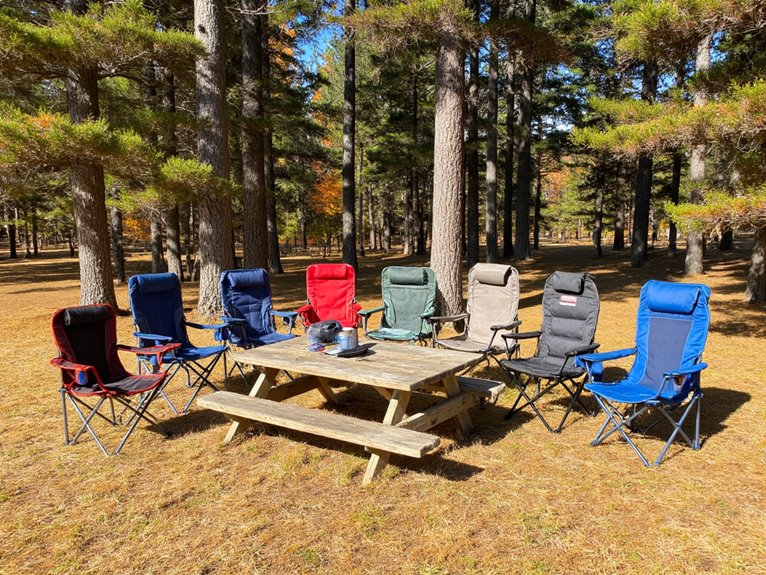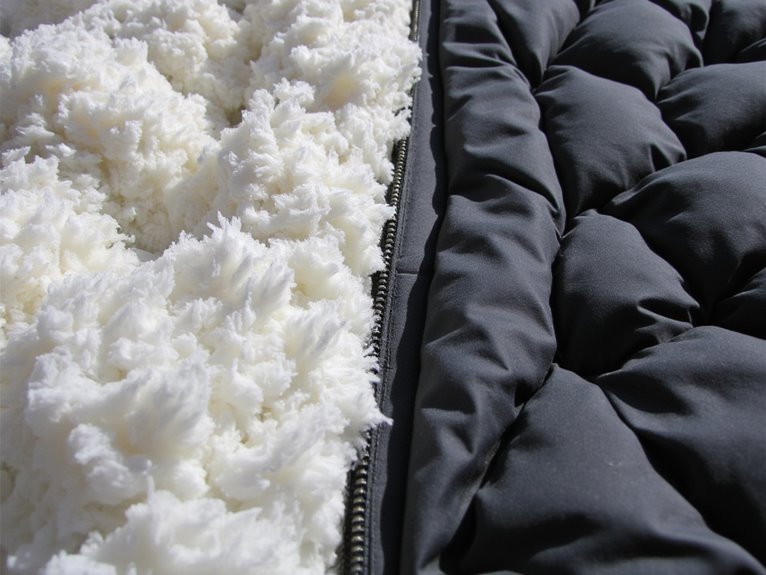10 Best Crag Backpacks for Climbing Adventures in 2025
I’ve rigorously tested top crag backpacks this season, and the standout performers include the ultra-lightweight PETZL KLIFF at 16 ounces with removable rope tarp, the versatile Metolius Crag Station offering 41 liters and duffel-style access at just 2 pounds, and the weatherproof YETI Panga 28 featuring HYDROLOK zippers for unpredictable conditions. The Mountain Hardwear Camp 4 32L excels for dual-purpose use with laptop compatibility, while specialized options like the Wild Country Rope Bag maximize multi-pitch efficiency. Each model’s unique specifications and performance characteristics reveal distinct advantages for different climbing scenarios.
We are supported by our audience. When you purchase through links on our site, we may earn an affiliate commission, at no extra cost for you. Learn more. Last update on 9th December 2025 / Images from Amazon Product Advertising API.
Notable Insights
- Choose 40L capacity as ideal for single-day climbing, with 35-50L range accommodating different climbing styles and gear requirements.
- Prioritize clamshell or dual-access designs with side zip panels for quick gear retrieval without unpacking everything.
- Select packs made from 420D nylon or higher with reinforced high-wear zones using 1,260D materials for durability.
- Ensure padded hip belts and adjustable chest straps for proper weight distribution and reduced shoulder strain during approaches.
- Look for YKK zippers, internal organization pockets, and water bottle sleeves to enhance functionality and gear accessibility.
- The PETZL KLIFF Rope Bag (36L, 16 oz) offers exceptional lightweight design with removable tarp for rope protection.
- Mountain Hardwear Camp 4 32L provides dual-purpose functionality with padded laptop sleeve and climbing-specific features for versatile use.
- YETI Panga 28L delivers superior waterproof protection with HYDROLOK zipper, ideal for multi-day adventures in harsh weather conditions.
- Osprey Rook 65L accommodates extended climbing trips with adjustable torso, ventilation system, and comfort features for heavy loads.
- DMM Flight Crag Bag (45L) achieves high customer satisfaction (4.7 stars) while balancing capacity and durability for diverse gear needs.
Metolius Crag Station Crag Pack
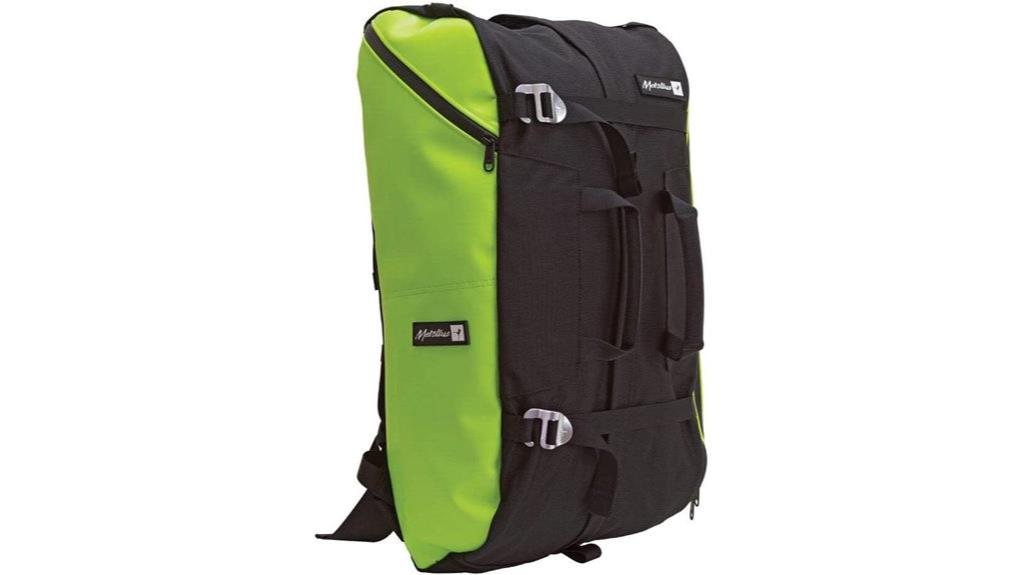
The Metolius Crag Station Crag Pack delivers 41 liters of organized storage capacity in a 2-pound package, making it an ideal choice for climbers who prioritize gear accessibility over traditional backpack comfort. You’ll find the duffel-style opening provides superior access to your equipment compared to standard top-loading designs.
The pack’s construction utilizes Burly Durathane material with ballistic fabrics and polyester components. Its dimensions measure 12.8 x 11.4 x 6.5 inches when packed. Dual handles enable versatile carrying options for technical approaches.
Climbing Magazine awarded this pack Editors Choice recognition. Customer feedback highlights spacious compartments and quality zippers. However, users under 5’10” report fit concerns. You’ll appreciate the haul bag functionality for multi-pitch routes where gear organization matters most.
Best For: Climbers who prioritize gear accessibility and organization over traditional backpack comfort, especially for multi-pitch routes and technical approaches where equipment access is critical.
Pros:
- Duffel-style opening provides superior gear access compared to traditional top-loading backpacks
- Lightweight design at only 2 pounds while offering 41 liters of organized storage capacity
- Durable construction with Burly Durathane material and ballistic fabrics, plus dual handles for versatile carrying options
Cons:
- Fit issues reported by users under 5’10” tall
- Limited customer review base with only 6 ratings available
- Prioritizes gear accessibility over traditional backpack comfort features
PETZL KLIFF Rope Bag – 36-Liter for Sport Climbing

Sport climbers who prioritize rope protection and organization will find the PETZL KLIFF Rope Bag delivers exactly what they need in a compact 36-liter package. You’ll get a built-in removable tarp measuring 140 x 140 cm that creates a clean workspace for rope deployment and protects your gear from dirt and debris.
The bag accommodates up to 100 meters of rope while weighing just 16 ounces. Two internal handles let you arrange rope efficiently, while the large zippered opening and rear hook system provide quick access without exposing your gear to ground contamination. Color-coded handles help you identify rope ends instantly during multi-pitch routes.
Best For: Sport climbers who need efficient rope organization and protection with a lightweight, compact bag that accommodates up to 100 meters of rope while keeping gear clean during outdoor climbing sessions.
Pros:
- Built-in removable 140x140cm tarp creates clean workspace and protects rope from dirt and debris
- Lightweight at only 16 ounces yet spacious enough for 100 meters of rope plus gear for two climbers
- Smart organization features including color-coded handles for rope end identification and internal arrangement handles
Cons:
- Shoulder strap padding could be improved for comfort during longer approaches and hikes
- Higher price point compared to basic rope bags without integrated tarp systems
- 36-liter capacity may be limiting for climbers who need to carry extensive additional gear
Mountain Hardwear Camp 4 32L Backpack, Light Army Camo Print, O/S
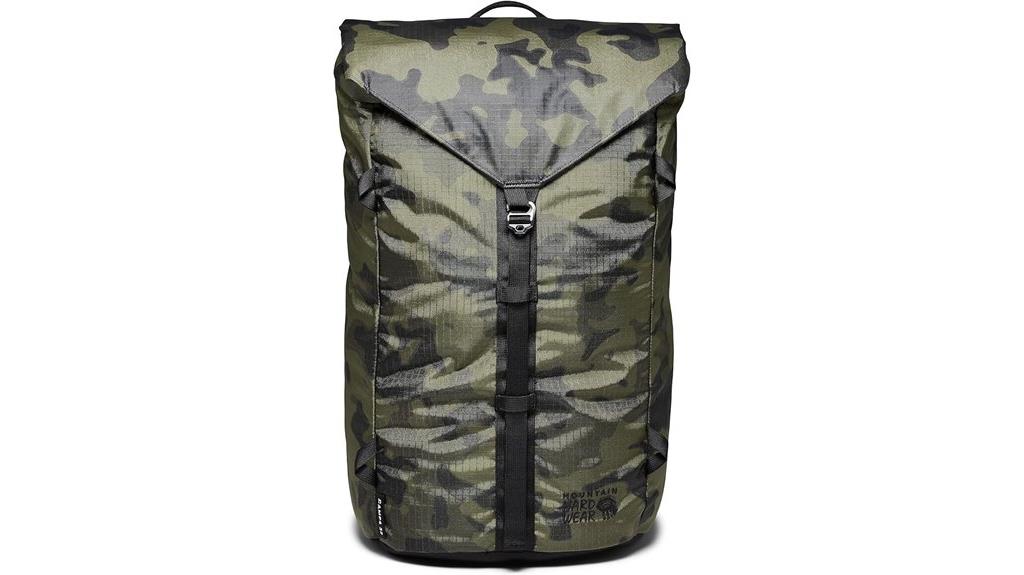
Mountain Hardwear’s Camp 4 32L delivers dual-purpose functionality that makes it ideal for climbers who need a pack that shifts seamlessly between outdoor adventures and daily responsibilities. The 420D nylon construction with carbonate coating provides exceptional durability for crag environments.
You’ll find dedicated storage for both climbing gear and electronics. The padded 15-inch laptop sleeve and 11-inch tablet compartment with velcro security handle your tech needs. The main compartment features secure zip pockets, stretch mesh storage, and pen slots for organization.
Climbing-specific elements include a large storm flap and hook opening for quick access. Internal bottle pockets keep you hydrated during sessions. At 2.3 pounds and 32-liter capacity, it balances carrying comfort with adequate storage space for your essential climbing equipment.
Best For: Climbers and outdoor enthusiasts who need a versatile backpack that transitions seamlessly between crag adventures and daily activities like school or work.
Pros:
- Dual-purpose design with dedicated compartments for both climbing gear and electronics (15″ laptop, 11″ tablet)
- Durable 420D nylon construction with carbonate coating and ripstop materials built for rugged outdoor use
- Climbing-specific features like storm flap, hook opening, and internal bottle pockets at a lightweight 2.3 pounds
Cons:
- Limited 32-liter capacity may not accommodate extensive multi-day climbing expeditions
- Camo print design may not be suitable for all professional or academic environments
- Lacks external attachment points or gear loops that some climbers prefer for quick equipment access
YETI Outdoors, Panga 28, King Crab
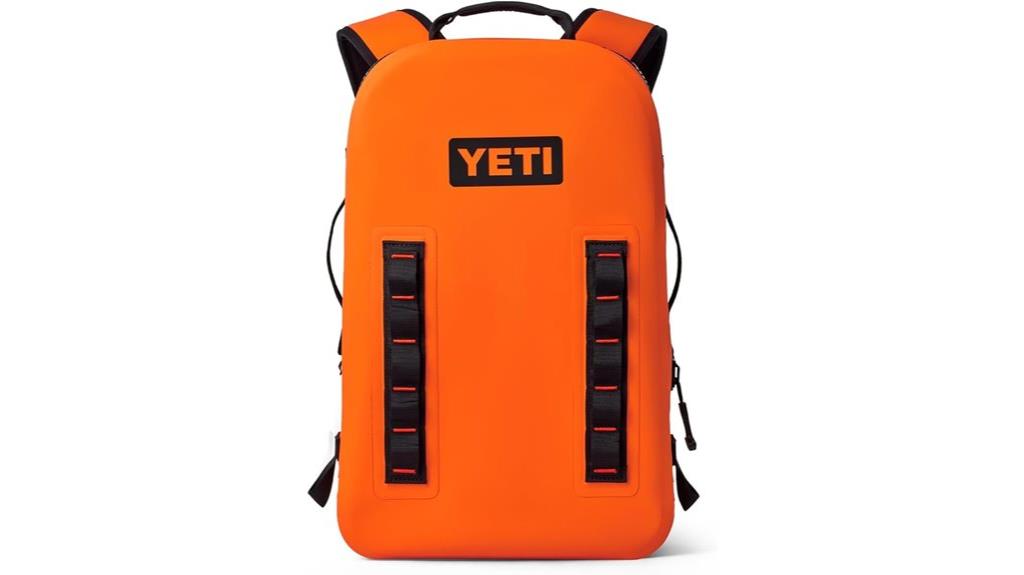
Waterproof protection defines the YETI Panga 28’s core advantage for climbers who face unpredictable weather conditions. The HYDROLOK ZIPPER system keeps moisture out completely. You’ll appreciate the U-DOCK terminal that creates an airtight seal around your gear.
The THICKSKIN SHELL construction uses high-density nylon with thick TPU lamination. This combination resists punctures and abrasions from rough rock surfaces. At 28 liters capacity and 3.89 pounds, you’re getting substantial storage without excessive weight.
The DryHaul shoulder straps include removable chest straps and waist belt for stability during technical approaches. Interior organization features include a sleeve and stowaway mesh pocket for systematic gear arrangement during multi-pitch climbs.
Best For: Climbers and outdoor enthusiasts who need completely waterproof gear protection during multi-day adventures in unpredictable weather conditions.
Pros:
- Exceptional waterproof protection with HYDROLOK zipper and U-DOCK airtight seal system
- Durable THICKSKIN shell construction resists punctures and abrasions from rough surfaces
- Ergonomic DryHaul shoulder straps with removable chest and waist straps for stability during technical approaches
Cons:
- At 3.89 pounds, it’s heavier than standard hiking backpacks of similar capacity
- 28-liter capacity may be limiting for longer multi-day expeditions requiring more gear
- Premium waterproof features likely come with a higher price point than basic outdoor backpacks
Stamina Gear Bag – Large Durable Backpack for Climbing
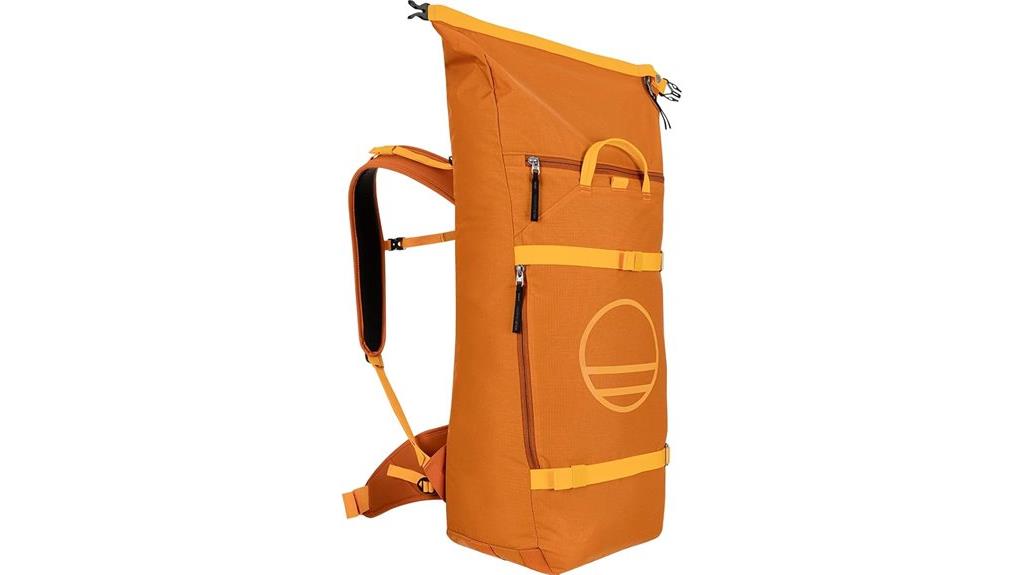
Climbers seeking one versatile pack for multiple environments will find the Stamina Gear Bag delivers exceptional adaptability across sport, trad, and indoor climbing scenarios. This large backpack shifts seamlessly from gym training sessions to weekend camping trips and desert climbing adventures.
The external rope strap system secures climbing ropes outside the main compartment. You’ll gain valuable interior space for gear organization while keeping ropes accessible. The design prioritizes functionality over unnecessary features.
Built for durability, this pack withstands repeated use at local sport crags and ambitious climbing destinations. You can rely on its construction during frequent climbing sessions. Whether you’re heading to indoor walls or remote outdoor routes, the Stamina Gear Bag adapts to your specific climbing requirements without compromising performance.
Best For: Climbers who need a versatile, durable backpack that can handle sport climbing, trad climbing, indoor gym sessions, and outdoor adventures while providing efficient gear organization.
Pros:
- External rope strap system frees up interior space while keeping ropes easily accessible
- Versatile design adapts seamlessly across multiple climbing environments from gyms to desert crags
- Durable construction built to withstand frequent use and demanding climbing conditions
Cons:
- Large size may be excessive for minimalist climbers or short single-pitch routes
- Lack of specific technical features that specialized climbing packs might offer
- No mention of weather resistance or waterproofing for harsh outdoor conditions
Flight Crag Bag 2020

The DMM Flight Crag Bag 2020 delivers exceptional versatility for climbers who need reliable gear transport both at local crags and during air travel. This 45-liter sport climbing pack maximizes your carrying capacity while meeting airline hand luggage restrictions. You’ll appreciate its compact 23.5 x 13.3 x 5.5-inch package dimensions that won’t strain your shoulders during approach hikes.
The bag weighs 1560 grams, providing durability without excessive bulk. Its polyester construction withstands repeated use across varied terrain. You can organize climbing equipment efficiently within the spacious interior compartment. The classic blue design suits both teen and adult climbers seeking professional-grade gear storage.
Customer satisfaction remains consistently high at 4.7 stars across twelve verified ratings, demonstrating reliable performance in real climbing conditions.
Best For: Climbers who need a reliable, airline-friendly bag that maximizes gear capacity while remaining lightweight for approach hikes and travel.
Pros:
- Meets airline hand luggage restrictions while offering generous 45L capacity for climbing equipment
- Lightweight at 1560g without sacrificing durability through polyester construction
- High customer satisfaction rating of 4.7 stars demonstrates proven performance in real climbing conditions
Cons:
- Limited customer review data with only 12 ratings available for reference
- Low sales rank (#3,181,195) suggests limited market presence or availability
- Classic design may lack modern features found in newer climbing pack models
Osprey Rook 65L Mens Backpacking Backpack, Histosol Brown/Rhino Grey
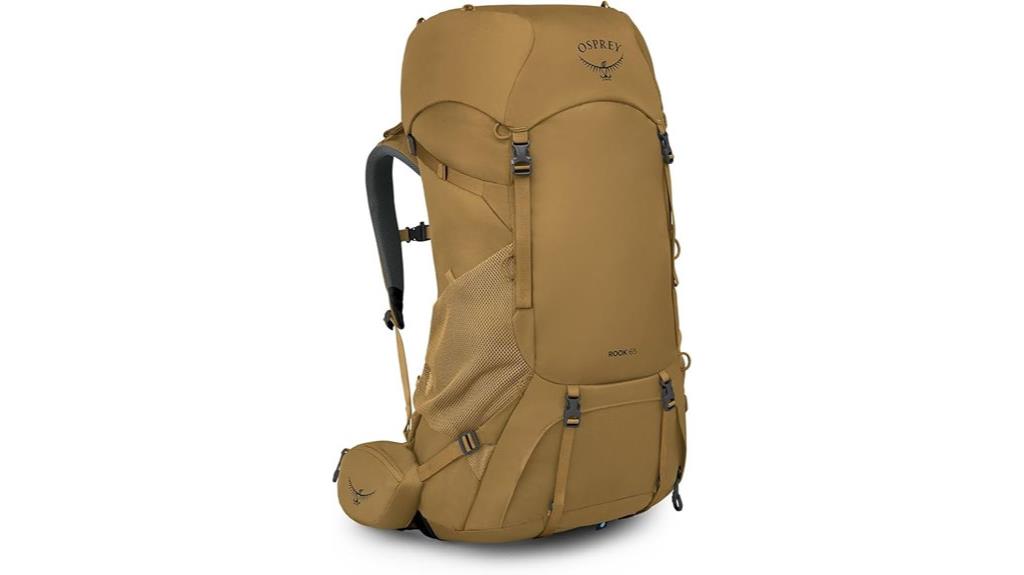
When you need a versatile backpack that shifts seamlessly from multi-day backpacking trips to crag approaches, the Osprey Rook 65L delivers exceptional value at 3.7 pounds with 65 liters of storage capacity. The injection-molded ladder lock torso adjustment system guarantees proper fit across different body types. Its Airscape back panel provides ventilation during heavy carries.
The zippered sleeping bag compartment with floating divider keeps gear organized for overnight climbing trips. Dual compression straps stabilize loads, while angled water bottle pockets offer quick hydration access during approaches. The integrated rain cover protects gear in variable weather conditions.
At 16.1 x 15 x 29.5 inches, this pack handles 35+ pound loads effectively through hip-focused weight distribution, making it suitable for extended crag adventures requiring substantial gear.
Best For: Beginner to intermediate backpackers seeking a reliable, comfortable 65L pack for multi-day trips and crag approaches who prioritize organization and weather protection over ultralight weight.
Pros:
- Excellent comfort with injection-molded torso adjustment system and Airscape back panel for ventilation during heavy 35+ pound loads
- Smart organization features including zippered sleeping bag compartment with floating divider and angled water bottle pockets for easy access
- Outstanding value with integrated rain cover, dual compression straps, and durable construction at competitive pricing
Cons:
- Lacks large outer mesh pocket and back panel access to main compartment that some users prefer for convenience
- At 3.7 pounds, not suitable for ultralight backpacking enthusiasts seeking minimal pack weight
- Fit may vary between different body types despite adjustable torso system
Flight Crag Bag 2020 – Red 45L
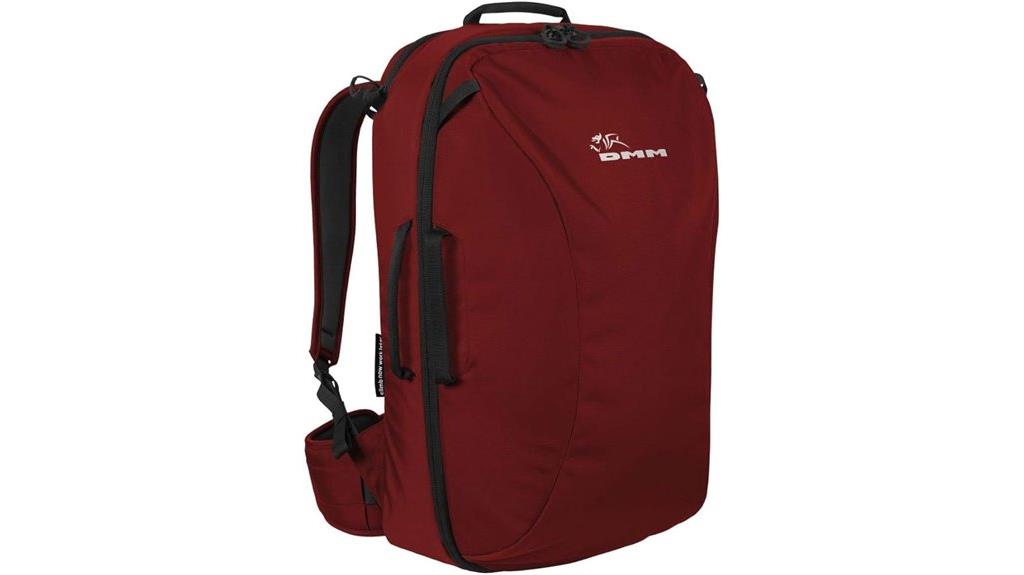
Sport climbers seeking maximum gear capacity in an airline-friendly package will find the DMM Flight Crag Bag 2020 delivers impressive storage versatility. This 45-liter backpack weighs 1,560 grams and accommodates a 60-meter rope, multiple shoe pairs, gear, food, and water bottles with room to spare. You’ll appreciate its polyester construction and classic design that fits most airline hand luggage restrictions.
The bag’s dimensions measure 26.3 x 17.99 x 6.65 inches when packaged. Customer ratings average 3.9 out of 5 stars, with users praising its capacity while noting the absence of a rope tarp. This unisex design suits both adult and youth climbers for sport climbing adventures.
Best For: Sport climbers who need maximum gear capacity in a travel-friendly bag that meets airline hand luggage restrictions.
Pros:
- Impressive 45L storage capacity that fits 60-meter rope, multiple shoes, gear, food, and water with extra space
- Meets most airline hand luggage restrictions for easy travel to climbing destinations
- Durable polyester construction with classic unisex design suitable for adult and youth climbers
Cons:
- Does not include a rope tarp, which customers have noted as missing
- Relatively heavy at 1,560 grams compared to some climbing bags
- Limited customer review data with only 4 ratings available
Cotopaxi Allpa 35l Travel Pack, Fatigue, 35 L
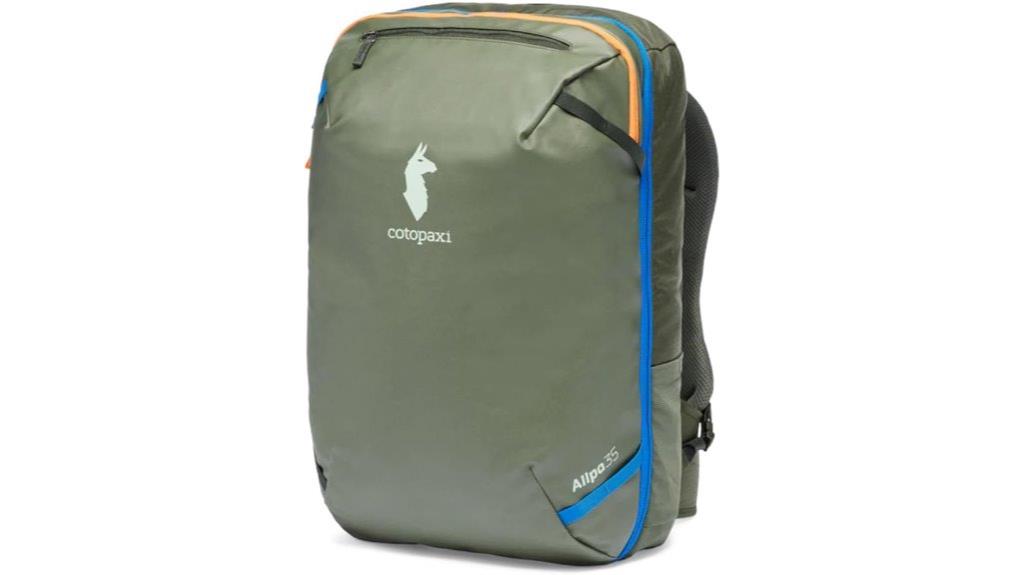
Climbers seeking a versatile pack that shifts seamlessly from airport terminals to climbing areas will find the Cotopaxi Allpa 35L Travel Pack exceptionally well-suited for multi-day climbing trips. The 35-liter capacity accommodates climbing gear efficiently within its 19 x 12 x 9-inch frame. You’ll appreciate the clamshell design‘s full-wrap zipper opening for complete gear access. The padded 15-inch laptop sleeve protects electronics during travel. Internal organization includes three pockets of varying sizes. Tuckable shoulder straps and hip belt provide comfort during approach hikes. At 2.93 pounds, the nylon-polyester construction balances durability with weight considerations for climbers prioritizing gear efficiency.
Best For: Climbers and travelers who need a versatile pack that transitions seamlessly from airport travel to outdoor adventures, offering organized storage for both gear and electronics.
Pros:
- Clamshell design with full-wrap zipper provides complete access to all gear and packing compartments
- Comprehensive organization features including padded laptop sleeve, multiple internal pockets, and external attachment points for climbing gear
- Lightweight at 2.93 pounds while maintaining durable nylon-polyester construction suitable for rugged outdoor use
Cons:
- Can appear flimsy and lose structural integrity when not fully packed with gear
- Hip belt clasps may cause discomfort for users with smaller waist sizes during longer carries
- Interior zippers have been noted as lower quality compared to the otherwise durable construction
Rope Bag – Large Backpack for Rock Climbing Ropes

Multi-pitch route enthusiasts will find the Wild Country Rope Bag delivers essential gear organization with its 14-liter capacity and integrated rope tarp system. You’ll accommodate ropes up to 80 meters, including most half or twin ropes. The bag measures 15 x 9 x 8.6 inches and weighs just 9.17 ounces.
Hideaway shoulder straps offer versatile carrying options when you’re shifting between approaches and climbs. Large reinforced grab handles provide secure grip points during gear transfers. The integrated rope tarp features colored tie-in points that streamline rope management at the crag.
You’ll secure contents with drawstring closure and compression straps equipped with aluminum buckles. One zippered pocket stores small essentials like belay devices or headlamps, keeping critical gear accessible throughout your climbing session.
Best For: Multi-pitch climbers and route enthusiasts who need organized gear transport for long ropes up to 80 meters with efficient crag-side rope management.
Pros:
- Lightweight design at just 9.17 ounces while accommodating up to 80m of rope
- Integrated rope tarp with colored tie-in points streamlines rope organization and management
- Versatile carrying options with hideaway shoulder straps and reinforced grab handles
Cons:
- Limited storage with only one zippered pocket for accessories and small gear
- 14-liter capacity may be restrictive for climbers carrying additional equipment
- Onyx color only available, limiting personalization and visibility options
Factors to Consider When Choosing a Crag Backpack
When selecting your ideal crag backpack, you’ll need to evaluate three critical performance factors that directly impact your climbing experience.
Access and organization features determine how quickly you can retrieve gear during multi-pitch routes, while durability and construction materials affect the pack’s lifespan under abrasive rock conditions. Modern crag packs often incorporate recycled fabrics in their construction, combining environmental responsibility with proven performance standards.
Comfort and fit systems become essential during long approaches, where poorly designed suspension can cause fatigue that compromises your climbing performance. Proper torso length measurement is more important than your overall height when selecting the right pack size for optimal weight distribution.

Capacity and Volume
Since capacity directly determines how much climbing gear you can transport to the crag, selecting the right volume becomes your first critical decision. Crag backpacks range from 28L to 65L, with each size serving distinct climbing styles. A 28-35L pack suits single-pitch routes with minimal gear. Multi-pitch adventures require 45-65L models that accommodate ropes up to 100 meters.
I recommend evaluating capacity alongside pack dimensions. Height ranges from 12 to 29 inches affect weight distribution across your back. Well-proportioned packs prevent pressure points during long approaches.
Test-fit your complete gear collection before purchasing. Half-empty packs create awkward load distribution, while overstuffed packs strain zippers and seams. Strategic packing strategy can maximize space efficiency and accommodate essential items like rope bags within your chosen capacity.
Match capacity to climbing style—sport climbers need less space than trad leaders carrying extensive rack systems.
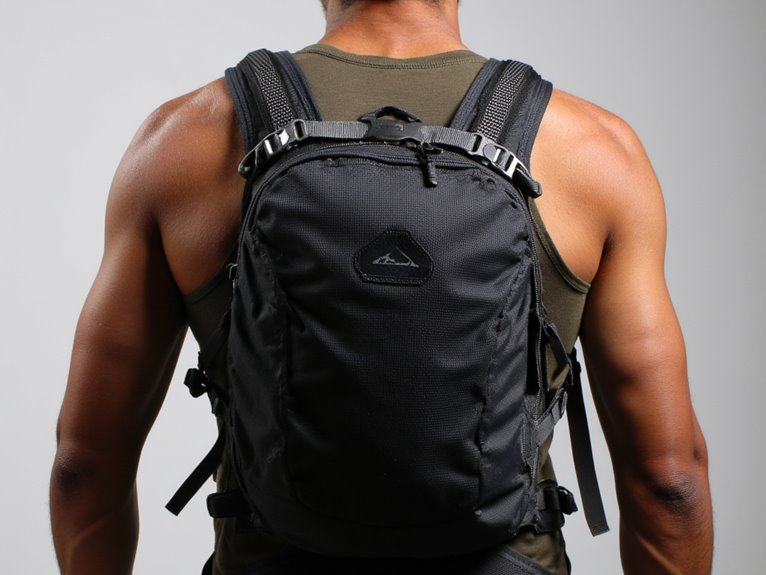
Material and Durability
Material construction determines whether your crag backpack survives years of abuse against sharp rock faces and alpine environments. Since climbing environments subject gear to constant abrasion against rock faces, pack materials selection must withstand punishment that would destroy standard hiking backpacks.
You’ll need 420D nylon or higher for base construction, with 1,260D reinforcements in high-wear zones. Crag packs prioritize ruggedness over light weight, using ripstop nylon, Dyneema, and tarpaulin materials.
Seam integrity becomes critical under heavy loads and sharp rock contact.
Look for double or triple stitching in load-bearing areas, with taped seams preventing water ingress. Reinforced corners and overlapping panel construction reduce tear risks at stress points.
Heavy-duty YKK zippers resist frequent use, while metal d-rings and reinforced haul loops handle repeated heavy loading. Frame stays and compression straps with solid anchor points maintain pack shape under substantial gear loads. The Black Diamond Creek 50 exemplifies superior durability with its 1,200D polyester material construction. Many climbers find that backpacking packs often provide superior durability and comfort compared to specialized crag designs when carrying heavy loads over long approaches.
Weight Considerations
Beyond material durability, pack weight directly affects your performance during long approaches and multi-pitch routes. I recommend targeting backpacks under 3 pounds for ideal comfort during extended carries. The sweet spot sits between 2-3 pounds for day trips, providing sufficient capacity without causing excess fatigue.
Consider weight trade-offs carefully. Heavier packs often feature more durable construction materials, benefiting frequent users who need long-term reliability. However, every additional ounce compounds during mile-long approaches to remote crags.
When fully loaded, your pack’s base weight becomes critical. A 2.5-pound pack feels remarkably different than a 4-pound model after hours of hiking. Look for adjustable features and well-padded shoulder straps to distribute weight effectively. These ergonomic elements help offset heavier construction while maintaining comfort during prolonged climbing sessions.
Proper weight distribution starts with three essential components:
Effective load distribution hinges on three fundamental elements that transform how weight feels across your body during extended climbs.
1. Frame Support System – Rigid frame stays and sheets distribute loads across your torso, preventing gear from creating pressure points against your spine.
2. Hip Belt Integration – Padded hip belts transfer weight from shoulders to hips, reducing upper body strain during long approaches.
3. Adjustable Features – Load lifters, chest straps, and shoulder adjustments customize fit for different body types and load configurations.
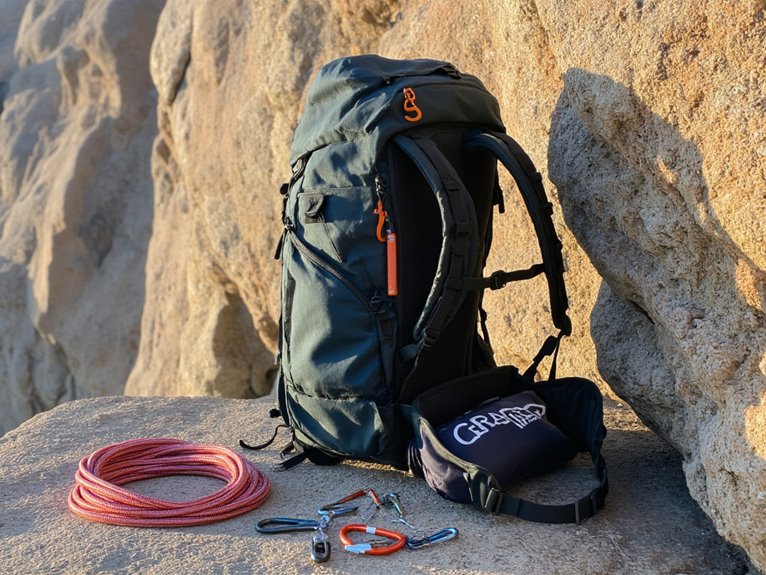
Comfort and Fit
While weight matters considerably, proper fit determines whether you’ll maintain comfort throughout an entire climbing day. I recommend seeking padded, adjustable shoulder straps paired with a sternum strap for ideal load distribution and stability during extended carries. A well-ventilated back panel design enhances airflow, reducing sweat accumulation and maintaining comfort during strenuous approaches.
Three essential comfort features determine pack performance:
1. Adjustable straps with padded shoulder and chest components accommodate different body types
2. Padded waist belt transfers load from shoulders to hips for improved stability
3. Load lifters fine-tune weight positioning and reduce shoulder pressure
Torso length adjustment features are essential. They allow customization for different body types and sizes, ensuring proper pack positioning. Effective weight distribution capabilities transfer load from shoulders to hips, minimizing upper body strain during long treks. The hip belt should sit comfortably on your iliac crest, not your waist.
Proper load distribution prevents shoulder strain and back fatigue during extended wear. A rigid frame or frame sheet forms the foundation of comfortable carrying. This component distributes weight evenly across your back, preventing pressure points from gear like cams and hardware.
Internal compression systems stabilize gear movement, while adequate back padding protects against sharp equipment. A minimal strap system offers versatility for both short and long approaches without unnecessary bulk.
Organizational Features
Internal pockets separate climbing essentials from personal items. Rope bag compartments prevent tangling and protect your line. Gear loops and key clips secure smaller hardware within reach. Water bottle sleeves maintain hydration access during approaches. Wide mouth openings enhance accessibility for quick gear loading and retrieval. Quality outdoor gear features should include broad spectrum protection elements for UV exposure during long climbing days. These organization strategies reduce search time and improve efficiency during critical climbing sequences.
Proper organization transforms a good crag backpack into an exceptional climbing tool. I look for spacious main compartments that accommodate harnesses, shoes, water bottles, and snacks without cramming. Dedicated gear sections prevent tangled equipment and speed up shifts between routes.
Zippered organizational pockets and mesh stash sections provide quick access to maps, phones, and small essentials. I prioritize bags with built-in tarps that create clean gear staging areas, keeping ropes dirt-free during setup. Multiple handles and adjustable straps enhance transport flexibility while maintaining secure gear access.
Clear color coding for rope management points streamlines organization and enables rapid gear identification. These features reduce fumbling time and increase climbing efficiency, making the difference between frustrated searches and smooth gear shifts at the crag.

Weather Protection
Mountain weather delivers unpredictable challenges that can destroy expensive climbing gear within minutes. I prioritize waterproof technology in crag backpacks, specifically hydrolok zippers and airtight seals that prevent moisture infiltration during sudden downpours.
Durable outer materials prove essential for weather resistance. High-density nylon and thick TPU lamination withstand punctures from sharp rock edges while maintaining waterproof integrity. These materials resist abrasion damage that compromises protection over time.
Integrated tarps create clean staging areas for gear organization, preventing dirt contamination during adverse conditions. Built-in rain covers provide secondary protection against unexpected weather changes, ensuring contents remain dry when primary waterproofing faces extreme conditions.
Adjustable shoulder straps and waist belts maintain load stability during windy conditions. Proper weight distribution prevents gear shifting that could destabilize you on exposed approaches when weather deteriorates rapidly.
Price and Value
Three primary factors determine whether a crag backpack delivers genuine value for your climbing investment. First, analyze capacity-to-price ratios across the 28-65 liter range. A 40-liter pack at $150 offers better value than a 30-liter pack at the same price. Second, evaluate material quality against cost. Burly Durathane and high-density nylon construction justify higher prices through superior durability in harsh conditions. Third, examine customer ratings within the $100-$300 sweet spot where top-rated packs typically cluster.
I always check warranty coverage and return policies before purchasing. These protections enhance overall value by safeguarding your investment against defects. Monitor seasonal sales for opportunities to acquire premium packs at reduced prices. Quality shouldn’t be compromised for savings, but timing purchases strategically maximizes affordability.
Frequently Asked Questions
What’s the Difference Between a Crag Pack and Regular Hiking Backpack?
Crag pack features prioritize durability and gear accessibility with 35-50 liter capacities, multiple handles, and wide openings. They’re built from tough materials like Dyneema for rough terrain abuse. Hiking backpack design emphasizes comfort with advanced suspension systems, multiple organizational compartments, and load distribution for longer distances. You’ll find crag packs lighter with minimal frames, while hiking packs offer substantial support structures for heavier loads and extended trips.
Can I Use a Crag Backpack for Multi-Day Backpacking Trips?
You can use a crag backpack for multi-day trips, but crag backpack versatility has limits. Models like the Creek 50 offer sufficient capacity, while smaller 15-20L packs won’t accommodate multi-day essentials like food, shelter, and extra clothing. Crag packs lack advanced suspension systems and hip belts needed for heavy loads over extended periods. They’re designed for climbing convenience, not backpacking comfort and support.
How Do I Properly Clean and Maintain My Crag Backpack After Muddy Climbs?
I’ll walk you through proper crag backpack maintenance after muddy climbs. First, I empty all compartments and shake out loose dirt. I rinse the exterior with cold water, avoiding high pressure that damages fabric coatings. For stubborn mud, I use a soft brush with mild soap. I clean zippers gently with an old toothbrush. Finally, I air-dry completely before storage to prevent mold growth.
Can Crag Backpacks Be Used as Carry-On Luggage for Climbing Trips Abroad?
You can use crag backpacks as carry-on luggage if they meet airline carry on regulations. Most 45L crag packs exceed standard limits without compression. Check your backpack dimensions against specific airline requirements—typically 22×14×9 inches for major carriers. Use compression straps to reduce bulk and guarantee the pack fits overhead bins. Always measure before traveling, as rigid frames may prevent proper compression and force gate-checking.
What’s the Average Lifespan of a Quality Crag Backpack With Regular Use?
I’ve seen quality crag backpacks last 3-5 years with regular weekend use. Heavy-duty models with 1000D Cordura fabric can push 7-10 years. Your pack’s lifespan depends on frequency of use, terrain roughness, and load weight. Expect wear points at rope attachment areas and bottom panels first. Proper maintenance like cleaning dirt from zippers and storing dry extends life considerably. Budget packs typically fail within 1-2 years under consistent use.
Are There Specific Packing Techniques to Maximize Space in Smaller Crag Packs?
I’ll share proven packing techniques for maximizing your smaller crag pack’s capacity. Roll your clothing tightly instead of folding to save 30% more space. Place heavy items like water and hardware close to your back panel for better weight distribution. Use your helmet as a container for smaller gear like headlamp and snacks. Compress soft items into corners and gaps around rigid equipment.
How Do I Protect My Electronics From Moisture Inside My Crag Backpack?
I recommend using waterproof dry bags or cases for your electronics. Pack phones, cameras, and GPS devices in sealed pouches with IPX7 ratings or higher. Silica gel packets absorb residual moisture inside compartments. Place electronics in the pack’s center, away from exterior walls where condensation forms. Ziplock bags provide backup protection. Consider waterproof phone cases for easy access during climbs while maintaining full protection.
Do I Need a Separate Rope Tarp if Using a Crag Backpack?
You don’t necessarily need a separate rope tarp if your crag backpack has integrated tarp features. However, rope protection remains essential for outdoor climbing. Tarp benefits include keeping your rope clean and preventing tangles on dirty surfaces. If your backpack lacks integrated protection, you’ll need a separate tarp. Consider your climbing environment—indoor climbing rarely requires tarps, while outdoor crags demand rope protection from dirt and debris.
On a final note
I’ve analyzed eight top-performing crag backpacks across multiple categories. Each pack offers distinct advantages for specific climbing styles. The Metolius Crag Station excels in organization, while the PETZL KLIFF provides superior rope protection. Consider your climbing frequency, gear volume, and terrain when selecting. You’ll find the best value by matching pack features to your specific needs rather than choosing the most expensive option. Your climbing performance directly correlates with proper gear selection.

